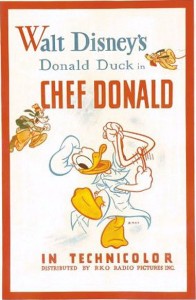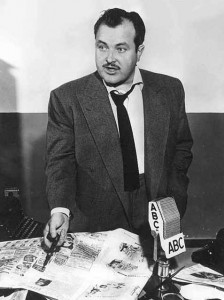Lee Morehouse. In the internal Disney Studio newsletter, The Bulletin Vol. 1, No. 22, March 21, 1939 is a brief biography of animator Lee Morehouse.
 “Lee Morehouse was born in Garvanza, California, which now is merely a province of South Pasadena. Lee has three sisters, one of which he is only ten minutes older than, because she is his twin.
“Lee Morehouse was born in Garvanza, California, which now is merely a province of South Pasadena. Lee has three sisters, one of which he is only ten minutes older than, because she is his twin.
“Lee’s artistic past began at the tender age of eight, when he drew the most magnificent airplanes and boats. At 12, he was copying Jiggs and Maggie, and at fifteen his first original cartoon was published in the high school paper.
“After this ambitious start in life, Lee went to U.S.C.
“The carefree days in college being over, Lee spent a whole summer hunting a job in Catalina.
“Lee says that he has known Fred Moore for nigh onto 12 years, and that he used to collaborate with Fred on comic strips for the Junior Times. In fact, Lee says ‘I knew Fred when he wrapped toilet paper for Ralph’s (supermarket) at ten bucks a week’.
“Fred had been at Disney’s about three years when he suggested to Lee that perhaps there might be a spot for the Morehouse talent. So in came Lee with samples and now he’s an animator in the annex. He’s got a three months old animator at home.”
Morehouse was born July 18, 1911 and passed away October 7, 1997 (age of 86) Morehouse’s Disney animation credits include the following:
1939: Society Dog Show, The Hockey Champ, Donald’s Cousin Gus, Officer Duck, The Autograph Hound
1940: Donald’s Dog Laundry, Mr. Duck Steps Out, Put-Put Troubles
1941: Chef Donald
1942: Donald’s Snow Fight
1948: A story credit for Inferior Decorator along with Bob Moore
Just One. While doing the Rocky and Bullwinkle series, actor Bill Conrad who was just doing the voice of the narrator on the show grumbled to Jay Ward and Bill Scott that he could do more than one voice. So Scott wrote a script with a couple of incidental characters like a gangster and the next time Conrad showed up to record, he saw he had three other minor parts besides the narration. When it came time to record the voice of the gangster, Conrad eagerly performed and everyone at the recording session looked at each other. It sounded exactly the same as the voice of the narrator. There was a pause and then voice artist Paul Frees popped in with “Bill Conrad, master of a thousand voice.”
Pascal on Animation. In 2006 with the release of Columbia Pictures’ motion capture animated film Monster House, Columbia Pictures Chairman Amy Pascal told the media: “Unlike a lot of other movie genres, animation speaks a universal language. The stories are simple and classic and in a funny way you can suspend disbelief in these stories in a way you can’t in ‘Miami Vice’. These movies also speak the visceral language of our age. Nobody believes long drawn-out arguments anymore, so animation feels especially vital in the way that an editorial cartoon can cut to the truth more effectively than a fifteen page news story.”
 The Mail Must Get Through. In Saludos Amigos (1943), little plane Pedro battles against storms and the terrors of the real South American mountain, Arconcagua and disappears. Almost magically, Pedro reappears and makes a sputtering upside-down landing to become a hero. In the precious mail satchel is only one postcard reading “Having wonderful time, wish you were here,” a cliched greeting sent by friends on vacation. The narrator (Fred Shields), adds: “Well, it might have been important.”
The Mail Must Get Through. In Saludos Amigos (1943), little plane Pedro battles against storms and the terrors of the real South American mountain, Arconcagua and disappears. Almost magically, Pedro reappears and makes a sputtering upside-down landing to become a hero. In the precious mail satchel is only one postcard reading “Having wonderful time, wish you were here,” a cliched greeting sent by friends on vacation. The narrator (Fred Shields), adds: “Well, it might have been important.”
The postcard was addressed to “Jorge Delano,” the cartoonist who was the Santiago guide for Walt and his artists on their South American trip. The postcard is from “Juan Carlos,” who hosted a party in Mendoza for Walt’s group before their flight to Santiago, Chile.

Art Stevens
He offered to trade Stevens for some of his own sketches but Stevens refused. Stevens always said that Ward was the most interesting person he’d ever known in his entire life, although he was not always flattering in his memories of Ward. Stevens animated most of the “strings” section in Toot, Whistle, Plunk and Boom and the talking statue heads in Mars and Beyond but had a rich career as both a Disney animator and later co-director on The Rescuers (1977) and The Fox and the Hound (1981).
The Map To Atlantis. Disney’s animated feature Atlantis: The Lost Empire (2001) may not have made a big splash but many people put in long hours to recreate that legendary culture. Marc Okrand, who developed Vulcan, Romulan and Klingon languages for the original Star Trek movie series, developed a language for Atlantis. The written language was developed by John Emerson. “The Atlantean [A] is a shape developed by John Emerson. It is a miniature map of the city of Atlantis (i.e., the outside of the swirl is the cave, the inside shape is the silhouette of the city, and the dot is the location of the crystal). It’s a treasure map,” stated co-director Kirk Wise.
The Human Cars. Stop, Look and Listen (1967) was a color ten minute live action short made by Len Janson and Chuck Menville using pixilation (a form of stop-motion animation). It was nominated in 1968 for an Academy Award.
The film contrasts the driving style of two drivers, who don’t have cars but use their own bodies like a car including leaving skid marks and a trail of transmission parts. The principal camera man was animator Dave Brain and it was primarily filmed in Griffith Park.
There is a scrolling list where the producers thank a long list of auto safety organizations, ending with, “…without whose contribution this film was made.”
Brain remembered, “Walt Disney himself saw our ‘dailies’ and authorized his editors to let us cut sounds from the Disney Studio library into our sound track. This was a month or two before Walt died and after he did, the studio passed on distributing the film. Len Janson got Chuck Jones to screen the film and he pitched it to MGM who bought and distributed it.”



 Jim Korkis is an internationally respected animation historian who in recent years has devoted his attention to the many worlds of Disney. He was a columnist for a variety of animation magazines. With his former writing partner, John Cawley, he authored several animation related books including The Encyclopedia of Cartoon Superstars, How to Create Animation, Cartoon Confidential and Get Animated’s Animation Art Buyer’s Guide. He taught animation classes at the Disney Institute in Florida as well as instructing classes on acting and animation history for Disney Feature Animation: Florida.
Jim Korkis is an internationally respected animation historian who in recent years has devoted his attention to the many worlds of Disney. He was a columnist for a variety of animation magazines. With his former writing partner, John Cawley, he authored several animation related books including The Encyclopedia of Cartoon Superstars, How to Create Animation, Cartoon Confidential and Get Animated’s Animation Art Buyer’s Guide. He taught animation classes at the Disney Institute in Florida as well as instructing classes on acting and animation history for Disney Feature Animation: Florida.




















































Jim:
That was definitely one of the weirder shorts I’ve ever seen,but at the same time,one of the most creative! It was kind of disgusting,but perfectly natural for the spedster to have the gas pump inserted into his mouth ,then have both he and the overly careful driver leaving slightly gross skid marks,knowing neither had an actual vehicle! It should have won the Oscar that year!
Menville and Janson also did a few more shorts in that vein, including “Vicious Cycles” and “Sgt. Swell of the Mounties.” They also scripted cartoons for Filmation and other studios.
Not to mention my favorite of all their shorts, Blaze Glory (1969).
And lest I forget – the live action section of Daffy Duck and Porky Pig Meet The Groovie Ghoolies.
Vicious Cycles, Blaze Glory and Sgt. Swell are available on DVD from Pyramid Media.
http://www.pyramidmedia.com/homepage/search-by-title/entertainment/blaze-glory-more-blaze-glory-vicious-cycles-sergeant-swell-detail.html
Remember watching Walt and El Groupo the documentary about Walt Disney and his entourage visiting South America a Chilen cartoonist wasn’t pleased that Pedro the Little Mail Plane was representing Chile so the cartoonist (which I can’t remember his name of the cartoonist) created a character based on a Condor (The majestic bird of Chile and the Andes region) and named him Condorito. The rest as they say is history and Condorito became the most popular comic strip character in Chile and all of Latin America.
Cartoonist name is René Ríos, I had to look it up I only knew him as “Pepo”
Chiliean cartoonist Rene Rios (“Pepo”) created the comics character called Condorito (“little condor”) in the Disney style in 1949. Condorito lives in a small town and behaves just like Donald Duck in Duckburg. Over the decades, the character has grown in popularity, even appearing briefly in the United States. However, he was created to show Walt Disney that he had “missed the boat” in trying to represent the character of Chile with Pedro instead of coming up with something more distinctive like Jose Carioca for Brazil.
The continued popularity/longevity of Condorito certainly prove Disney was wrong in the end when assigning a plane to represent Chile.
I recall this short being shown on TCM during their Academy Awards month. I always wonder: is the Milt Grey credited in this short the animation historian of the same name?
Yes, it is. You’ll see Milt’s name on Bakshi’s earliest features (Fritz The Cat, Heavy Traffic, etc.) as well as on The Simpsons (in fact, he’s even directed several episodes of The Simpsons).
I have one of his old books on animation I picked up nearly a quarter century ago about getting into the animation business (by then, still nearly transitioning to digital).
Somebody needs to write a book about Menville & Janson. Those two guys were very creative and funny!
Boy, that “Stop, Look and Listen” short was something! I’ve never seen or heard of it before. It’s awesome that they got to use Disney sound effects on it.
The short was very entertaining. Back in the 60’s there was a gasoline commercial that used the same special effects. Don’t remember what oil company the ad was for, though.
I remember it was Gulf. Perhaps Menville and Janson did those commercials as well.